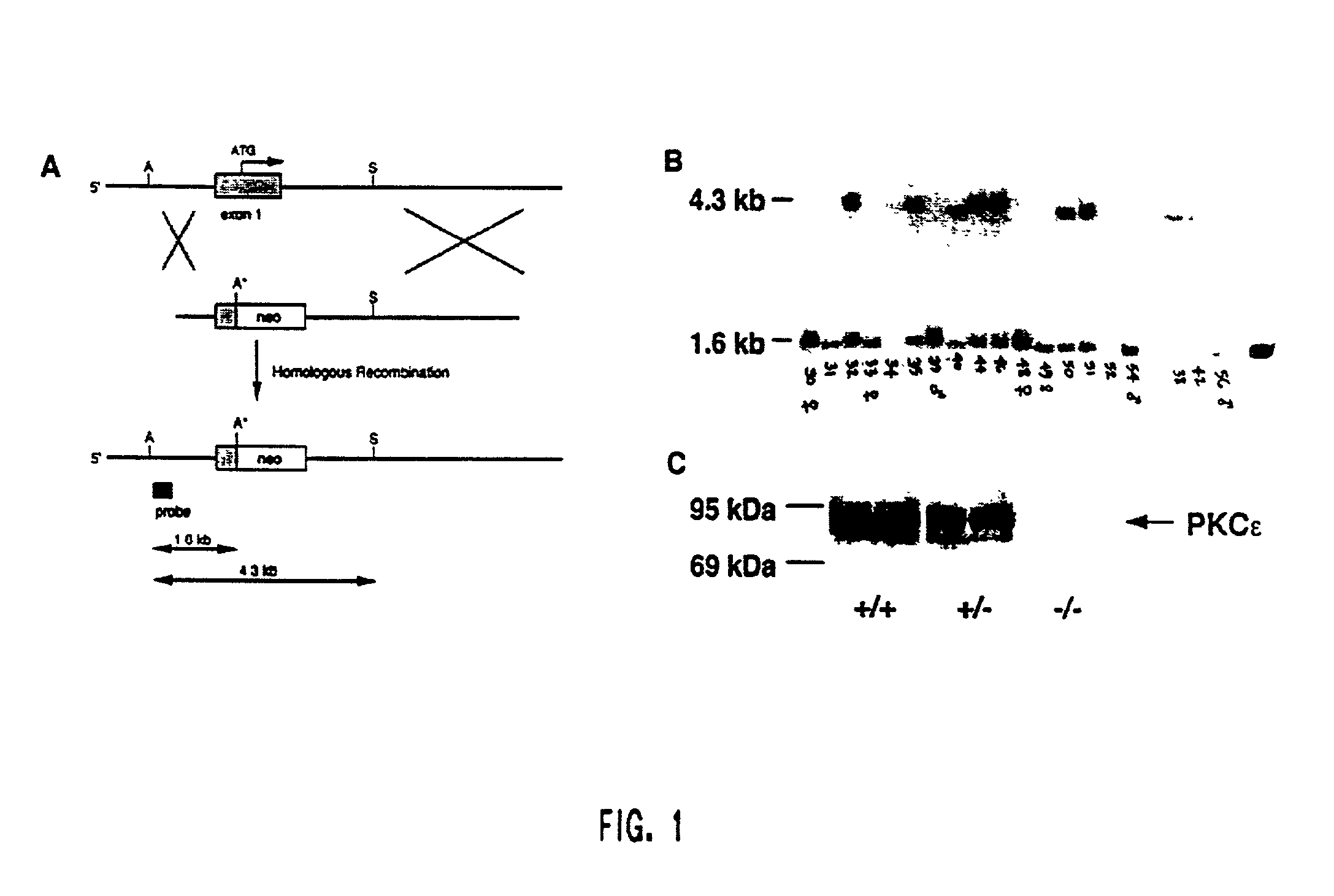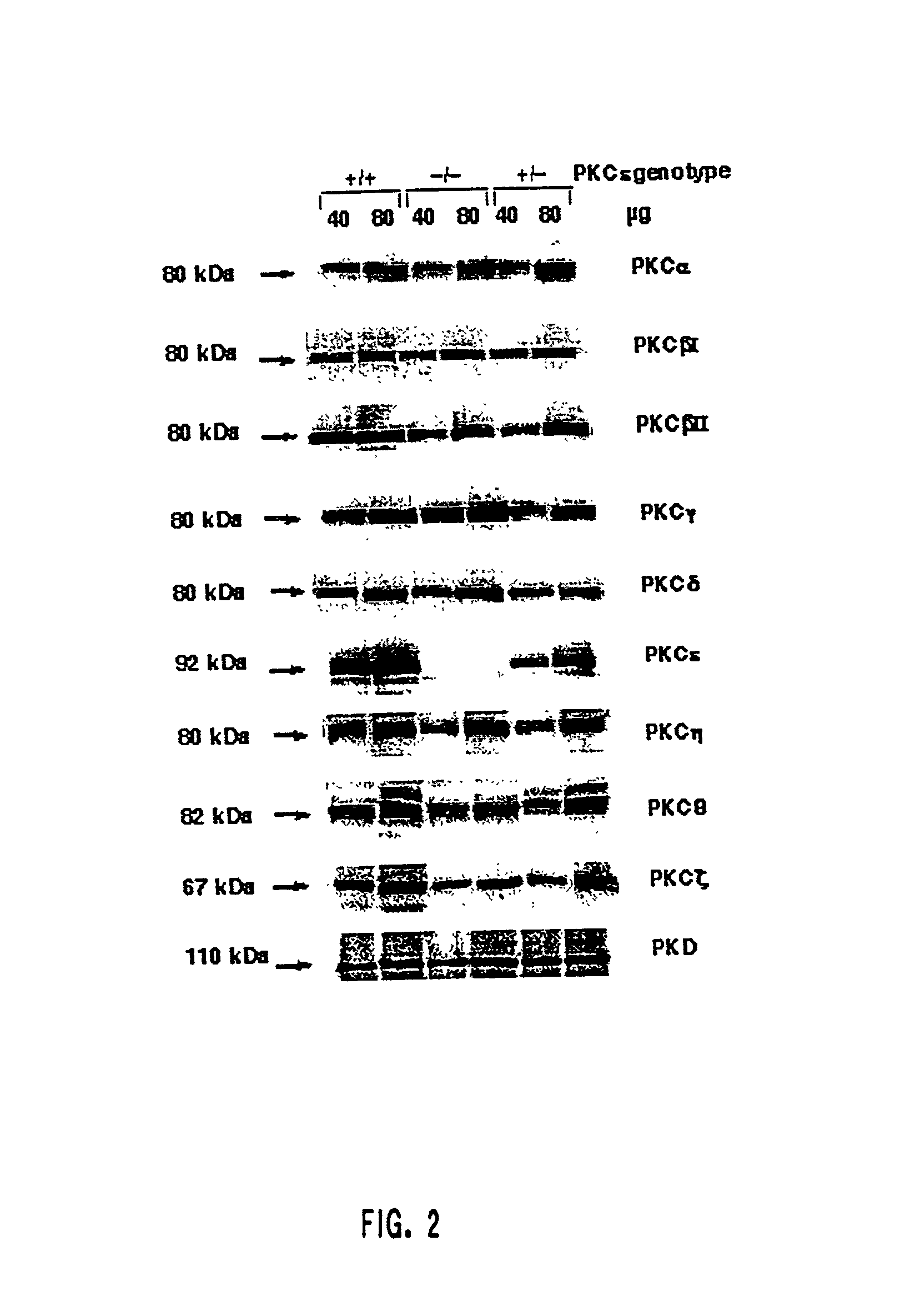Protein kinase c epsilon as modulator of anxiety, alcohol consumption and self-administration of drugs of abuse
a technology of protein kinase c epsilon and anxiety, which is applied in the direction of drug composition, tissue culture, enzymology, etc., can solve the problems of few drugs that modify alcohol intake, large public health problems, and the genetic factors that influence alcohol's effect on brain and behavioral processes remain largely uncharacterized, so as to reduce consumption
- Summary
- Abstract
- Description
- Claims
- Application Information
AI Technical Summary
Problems solved by technology
Method used
Image
Examples
example 1
A. Example 1
Generation of a PKC.epsilon.- / - Mouse
[0226] Ethanol potentiates NGF-induced activation of mitogen-activated protein kinases and neurite outgrowth in PC12 cells by a PKC.epsilon.-dependent mechanism (Roivainen et al., 1993, Brain Res. 624:85-93; Roivainen et al., 1995, Proc. Natl. Acad. Sci. USA 92:1891-1895; Hundle et al., 1995, J. Biol. Chem. 270:30134-30140; Hundle et al., 1997, J. Biol. Chem. 272:15028-15035). Since neural plasticity (Nestler and Aghajanian, 1997, Science 278:58-63) may contribute to drug dependence, we became interested in the role of PKC.epsilon. in behavior-modulating effects in mice. The following describes the generation of PKC.epsilon..sup.- / - mice by homologous recombination (Joyner A J, ed. Gene Targeting. The Practical Approach Series, ed. Rickwood D. and Harries B. D. 1993, IRI Press: New York).
[0227] A strategy was designed to create a targeting vector that would "knock out" 1.2 kb of the genomic DNA sequence for mouse PKC.epsilon., includi...
example 2
B. Example 2
CNS Morphology in PKC.epsilon.- / - Mice
[0230] Using the procedure described in Example 1, a total number of over 80 PKC.epsilon..sup.- / - mice has been identified. The CNS morphology in the mutant mice has been characterized as follows.
[0231] The overall brain structure appears normal both grossly, and microscopically by hematoxylin and eosin staining. However, fiber staining reveals structural abnormalities in the stratum radiatum of the CAI sector in 6-month old knockout mice. There, MAP-2 immunoreactive apical dendrites are shorter and appear to branch earlier than in wild-type littermate controls (FIG. 3). In addition, staining for acetyl cholinesterase reveals a decrease in cholinergic innervation of the hippocampus of PKC.epsilon..sup.- / - mice (FIG. 4). Despite these alterations in hippocampal morphology, no deficit in spatial learning was found in 6 week-old PKC.epsilon..sup.- / - mice as assessed by Morris water maze.
example 3
C. Example 3
Behavioral Studies in PKC.epsilon.- / - Mice
[0232] The following is an analysis of the behavior of PKC.epsilon..sup.- / - mice.
[0233] Basic Characterization. PKC.epsilon..sup.- / - mice demonstrated normal body weight, eating, drinking over a two-week period as compared to litter-mate wild-type controls at about 60 days of age (FIG. 5). Similarly, PKC.epsilon. mice demonstrated normal spontaneous locomotor behavior and habituation to a novel environment as compared to wild-type controls during three daily 1-hour tests (FIG. 6 and TABLE I).
1 TABLE I Day 1 Day 2 Day 3 PKC.epsilon..sup.+ / + PKC.epsilon..sup.- / - PKC.epsilon..sup.+ / + PKC.epsilon..sup.- / - PKC.epsilon..sup.+ / + PKC.epsilon..sup.- / - Horizontal Dist, in 4300 .+-. 239 4800 .+-. 215 2517 .+-. 593 3327 .+-. 223 2459 .+-. 521 4300 .+-. 239 Ambulatory events 4110 .+-. 596 4531 .+-. 453 2308 .+-. 496 2375 .+-. 580 2242 .+-. 511 2796 .+-. 498 Time ambulatory, sec 502 .+-. 53 554 .+-. 46 286 .+-. 53 286 .+-. 58 275 .+-. 55 327 ....
PUM
| Property | Measurement | Unit |
|---|---|---|
| intracellular concentration | aaaaa | aaaaa |
| body weight | aaaaa | aaaaa |
| molecular weight | aaaaa | aaaaa |
Abstract
Description
Claims
Application Information
 Login to View More
Login to View More - R&D
- Intellectual Property
- Life Sciences
- Materials
- Tech Scout
- Unparalleled Data Quality
- Higher Quality Content
- 60% Fewer Hallucinations
Browse by: Latest US Patents, China's latest patents, Technical Efficacy Thesaurus, Application Domain, Technology Topic, Popular Technical Reports.
© 2025 PatSnap. All rights reserved.Legal|Privacy policy|Modern Slavery Act Transparency Statement|Sitemap|About US| Contact US: help@patsnap.com



